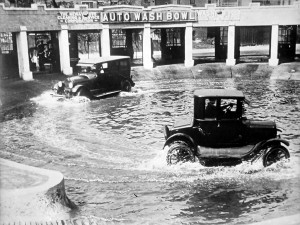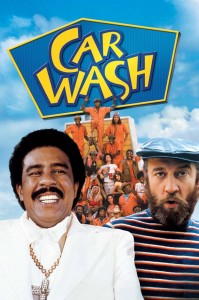Last winter’s record snow was a tough obstacle for many retailers and put the big chill on the travel business. But at least one industry finds itself cleaning up as the weather begins to warm up and motorists try to cope with the build-up of corrosive salt and grim.
No better way for the car wash industry to celebrate its 100th anniversary. More precisely, it’s the centennial of the “production line” car wash, an event brought 5,600 industry professionals to Chicago for the annual International Carwash Association convention.
That’s actually a small representation of an industry that now operates an estimated 150,000 retail car wash locations around the world. But the trade group has gone high-tech for its big anniversary, setting up a special carwash page on Facebook, among other things, allowing members to share vintage photos and stories – as well as modern tips of the trade.
Motorists have, of course, been washing their cars since the first vehicle hit the road – a globe-changing event generally attributed to Carl Benz and dating back to 1885. But for nearly three more decades, folks had to handle the dirty work on their own, with hoses, buckets, soap and brushes.
(March auto sales warm up as the country thaws out. Click Here for the full story.)
There’s long been debate over who came up with the idea of automating the process, but credit is routinely given to partners Frank McCormick and J.W. Hinkle, who opened up the “Automobile Laundry” in, appropriately, the Motor City in 1914.
In reality, it wasn’t much more sophisticated than the corner carwashes set up every spring as fundraisers by Scouts and school band members. Initially, cars were manually pushed through an assembly line-like tunnel where workers were each assigned a specific task, like applying soap, rinsing the vehicle and then drying it off.
Perhaps it was equally appropriate that the first automated wash opened in 1940 in car crazy California. Hollywood, to be more precise. A primitive winch system would tow a vehicle through the tunnel, though employees still had to handle most of the dirty work of scrubbing the vehicle clean.
By 1946, Thomas Simpson had designed and built a system that used an overhead sprinkler to wet down the vehicle but his update still relied on manual labor to handle the rest of the job.
It wasn’t until 1951 that Seattle-based brothers Archie, Dean and Eldon Anderson figured out how to completely automate the process, adding nozzles to apply soap and later rinse a vehicle, with automated brushes to scrub off the grime. At the end of the line, a 50-horsepower blower finished the drying process.
(All new vehicles will have to come with backup cameras by 2018, feds rule. Click Here for more.)
The process has steadily improved over the years. Softer cloth brushes are today commonplace, as are entirely brushless systems. Pressured to clean up its own act, the industry has adopted such environmentally friendly ideas as recirculating water systems. And today’s soaps are generally less harsh and even bio-degradable.
This year’s International Carwash Association brought out more than 300 exhibitors showing off their latest soaps, washing systems and other new tools for the trade.
There are all manner of alternatives, in fact, for motorists who want to see their paint shine again, including self-service washes and stationary in-bay systems that take up less space and are often found next to corner gas stations.
There are even mobile car washes that can be taken to homes or offices, and are often part of a more intensive cleaning process known as detailing.
Despite all the advances carwashes still require a fair share of labor, as was highlighted by the 1976 hit film, Car Wash, and the catchy disco hit it spawned, Workin’ at the Carwash. According to the trade group, there are today at least 500,000 people employed by carwashes around the world.


